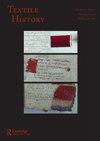‘Hand in Hand: The Artistic and Spiritual Life of Dame Werburg Welch’, William Allen Gallery, Ushaw College, Durham, UK, 6 April–29 June 2019
IF 0.1
2区 社会学
0 HUMANITIES, MULTIDISCIPLINARY
引用次数: 0
Abstract
The celebrants stand as an assembled congregation in the William Allen Gallery, Ushaw College, facing silently towards you as you enter the exhibition and encouraging you to wander amongst them. Each figure is simply presented on a small raised plinth, each with an unobtrusive text panel. There are no barriers to impede your enjoyment of the textiles, the construction of the embroidery or the woven decoration. Each figure is dressed in an example of the designs of Dame Werburg Welch (1894–1990), skilfully worked by the hands of her fellow sisters of Stanbrook Abbey. Eighteen copes, chasubles and dalmatics are displayed. In the colours of the liturgy, they are adorned with striking orphreys and hoods. The designs are treated with restraint, blending images that are both powerful and tender. They do not overwhelm the vestments, nor would they have been a distraction to the congregation when they were in use. Instead, the messages they convey are reverential, and they are executed with radical simplicity. In 1915 Eileen Grace Welch entered the novitiate at Stanbrook Abbey, taking on the name ‘Werburg’ after the seventhcentury Anglo Saxon saint, and was given the honorary title of ‘Dame’ in line with Benedictine tradition. Art was her passion. Welch had studied art at Bournemouth and later Bristol art schools, where she excelled in life drawing. On entering Stanbrook Abbey she had expected to give up art in this contemplative and“手拉手:韦尔奇夫人的艺术与精神生活”,英国达勒姆Ushaw学院威廉·艾伦画廊,2019年4月6日至6月29日
在乌肖学院威廉艾伦画廊,庆祝者们聚集在一起,当你进入展览时,他们默默地面向你,鼓励你在他们中间漫步。每个人物都简单地呈现在一个小的凸起底座上,每个底座都有一个不显眼的文本面板。没有任何障碍会阻碍你享受纺织品、刺绣或编织装饰的乐趣。每个人物都穿着维尔堡-韦尔奇女爵士(1894-1990)的设计,由她在斯坦布鲁克修道院的姐妹们熟练地完成。显示了18个作用域、chasubbs和dalmatics。在礼拜仪式的颜色中,他们装饰着引人注目的孤儿院和兜帽。设计受到约束,融合了既有力又温柔的图像。它们不会压倒法衣,也不会在使用时分散会众的注意力。相反,他们传达的信息是虔诚的,而且执行起来非常简单。1915年,Eileen Grace Welch进入斯坦布鲁克修道院见习,以七世纪盎格鲁撒克逊圣人的名字命名为“Werburg”,并根据本笃会的传统被授予“Dame”的荣誉称号。艺术是她的爱好。韦尔奇曾在伯恩茅斯和后来的布里斯托尔艺术学校学习艺术,在那里她擅长生活绘画。一进入斯坦布鲁克修道院,她就期望放弃这种沉思和沉思的艺术
本文章由计算机程序翻译,如有差异,请以英文原文为准。
求助全文
约1分钟内获得全文
求助全文
来源期刊

TEXTILE HISTORY
HUMANITIES, MULTIDISCIPLINARY-
CiteScore
1.00
自引率
0.00%
发文量
0
期刊介绍:
Textile History is an internationally recognised, peer reviewed journal and one of the leading publications in its field. It is viewed as an important outlet for current research. Published in the spring and autumn of each year, its remit has always been to facilitate the publication of high-quality research and discussion in all aspects of scholarship arising from the history of textiles and dress. Since its foundation the scope of the journal has been substantially expanded to include articles dealing with aspects of the cultural and social history of apparel and textiles, as well as issues arising from the exhibition, preservation and interpretation of historic textiles or clothing.
 求助内容:
求助内容: 应助结果提醒方式:
应助结果提醒方式:


